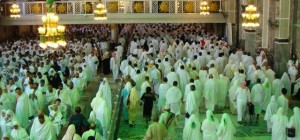By Arwa Aburawa www.greenprophet.com
A high speed train to Mecca in Saudi Arabia will cut down on carbon emissions during hajj this year, but its reach is limited.
 Every year, around three million Muslims from across the world prepare for the spiritual journey of a lifetime. Many will have been saving up for the trip for years and will be prepared to travel thousands of miles to reach their destination: Mecca in Saudi Arabia to perform the hajj.
Every year, around three million Muslims from across the world prepare for the spiritual journey of a lifetime. Many will have been saving up for the trip for years and will be prepared to travel thousands of miles to reach their destination: Mecca in Saudi Arabia to perform the hajj.
As one of the five pillars of Islam, every Muslim who has the financial and physical ability is encouraged to make the pilgrimage to Mecca which is Islam’s most holy site. The question is can this spiritual pilgrimage, which leaves behind a trail of waste and carbon emissions, really be transformed into something more green?
Progress Towards A ‘Green Hajj’
The concept of a ‘Green Hajj‘ has already been discussed here at GreenProphet following the UN-backed Muslim Seven Year Plan which announced plans to encourage Muslims to be more environmentally friendly. Although there was talk of printing Qur’ans on sustainably sourced paper, reducing energy consumption at mosques and places of worship, many were cynical as to whether these plans would ever materialize. However, this year for the first time ever, pilgrims will be able to reduce their carbon footprint during hajj by travelling between Mecca’s holy sites via a very green form of public transport- the train.
From this November 2010, the high speed train will be able to transport 130,000 passengers between the holy sites which will help reduce the number of vehicles on the roads and make hajj journeys more eco-friendly. Sadly, only pilgrims from Saudi Arabia and the Arab Gulf states will be able to purchase tickets and make full use of the trains this year. (My auntie and her family are going to hajj this year from the UK and I was going to ask her for a blow-by-blow account of using the metro but I guess that won’t be happening.)
Reducing Congestion and Pollution
The Mekkah Metro, as its been dubbed, is only in the first stages and is operating at 33 percent of its total capacity. It will be fully operational by hajj season 2011 and will carry around 500,000 passengers by then at the rate of 72,000 passengers an hour in a single direction. By the final stage in 2012 the metro, which has elevated tracks to avoid busy roads, will be able to transport up to two million people. This rail network is expected to reduce traffic by approximately 30,000 cars- so not only will it reduce congestion but it will also cut the noxious emissions which cars release.
The introduction of the train network is clearly an important step towards making hajj more environmentally-friendly but there is still a lot more to be done. It is estimated that 100 million plastic bottles are left behind every year after the hajj season and food packaging is still a big issue that needs to be tackled alongside the carbon emissions of the travellers. Although the flora and fauna around the two holy sites in Saudi Arabia are protected by a hima, a middle-eastern form of environmental protection, more is needed before a truly ‘Green Hajj’ is realized.
















